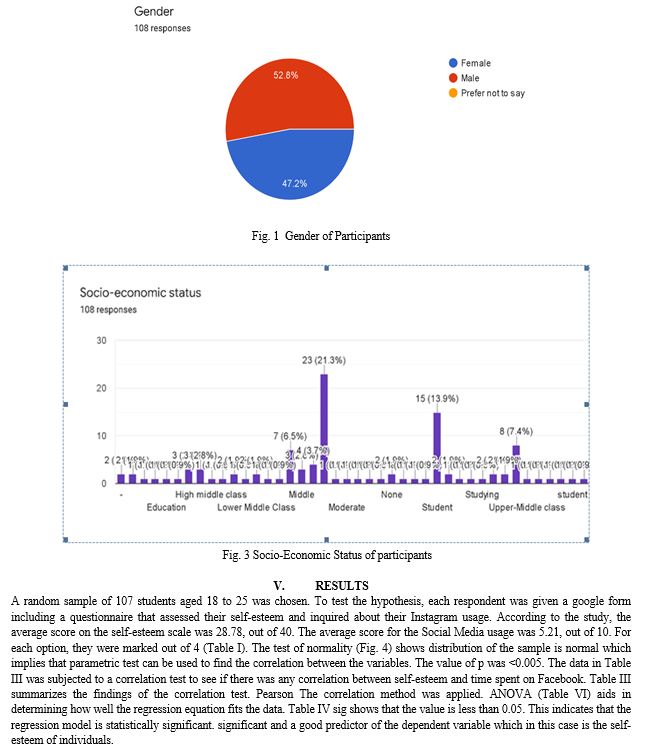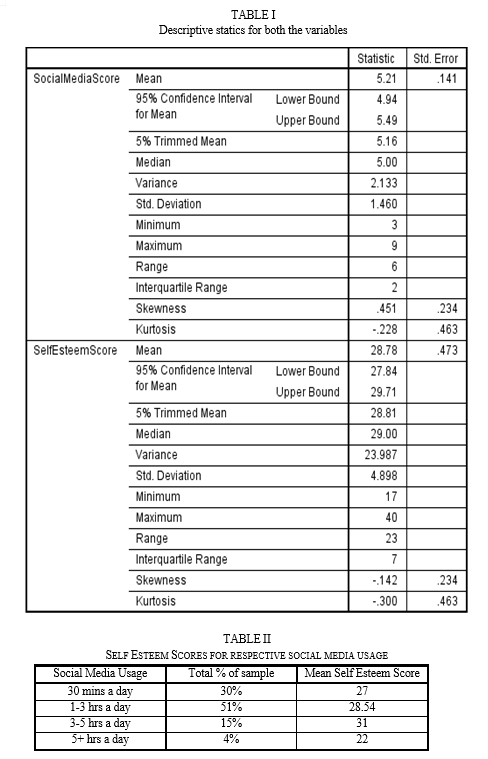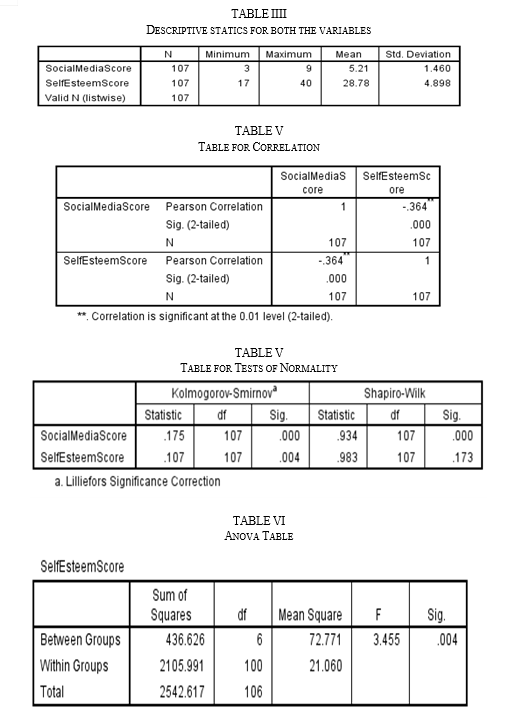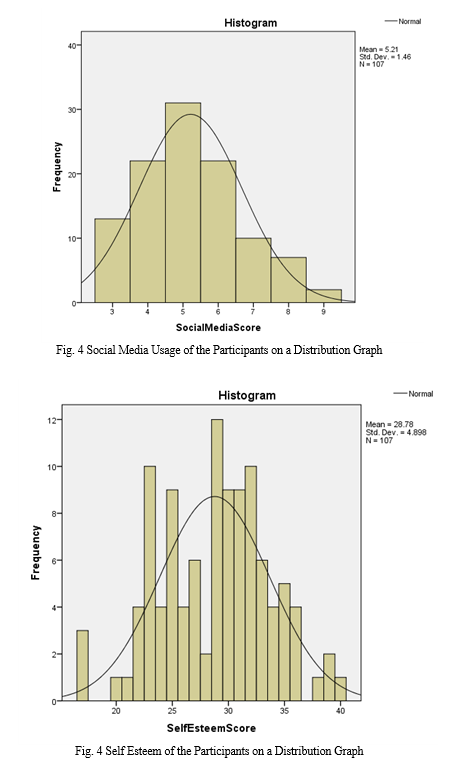Ijraset Journal For Research in Applied Science and Engineering Technology
- Home / Ijraset
- On This Page
- Abstract
- Introduction
- Conclusion
- References
- Copyright
The Paradox of Social Media: Self-Esteem Among Young Adults in India
Authors: Sidharth Mishra
DOI Link: https://doi.org/10.22214/ijraset.2024.63818
Certificate: View Certificate
Abstract
The world of technology has expanded swiftly and enormously since its origin. It has changed the ways in which youth interact, connect, and share with one another. Social media has a power that has long lasting effects on people and leads to change in behaviour. As the number of social media sites and applications keep going on the rise, so does their use by adolescents. During youth, children are witnessing the process of identity development and self- esteem is an important part of this development. During this experimental period, adolescents’ self- esteem is most likely to be moulded by the feedback they receive online through their consumption of various social media sites. Adolescence and young adulthood are pivotal stage in development where youth usually being to create their own identity and form meaningful connections, but social media usage of youngsters can impact on this area of their development hence this paper examines the relationship between the social media and its impact on self-esteem of youngsters. A viable hypothesis that has been used in the present research study is that there is a relation between social media and the self-esteem of youngsters. To test out this hypothesis a correlational analysis was conducted on a sample of 100 youngsters between the ages 18-24. According to the results of current research study, approximately 30% of the people use social media for at least 30 minutes in a day. 51% use social media for 1-3 hours a day. 15% people use social media for 3-5 hours a day. 4% people use social media for more than 5 hours a day. There is a clear link between individuals\' self-esteem and their use of social media. More so that increased social media usage is negatively linked Both of these variables are significant.
Introduction
I. INTRODUCTION
A. Background
At the beginning age for a man or woman, the use of the internet is step by step reducing and the common quantity of time spent on the net is growing very rapidly. A destiny without the internet is extraordinarily impossible. This rapid and evolving ubiquitous medium is impacting social things of man or woman and societies-the quantity of the effect is inchoate and dynamically evolving. Uncontrolled use results in troubles withinside the old and young alike main to behavioural troubles. The telecom zone has redefined the arena boundaries. In India, the adventure of the telecom zone from Telstra, MTNL, BSNL, Airtel, Vodafone, and Idea to Jio has super transition points. Jio`s access withinside the telecom marketplace added disruption among different gamers working withinside the marketplace and as a result, withinside the 12 months of 2020 Jio has ended up the marketplace chief withinside the telecom carrier issuer category. The telecom zone has converted from the pager gadget to mobile systems. The alternative from 1G to 4G has modified the existence of many humans withinside the world. This revolution in India become added via way of means of Reliance Jio in which they upgraded Indian the marketplace from 3G offerings to 4G offerings. They have a first-rate plan to transport to 5G withinside the close to. In the previous few years, the smartphone enterprise has visible a wonderful alternative and the call for clever telephones has long gone very high. With the alternative in verbal exchange medium, up to date generation, and affordability the amount of sale for clever telephones have long gone high. The call for those clever telephones may be visible on a huge scale to a number of the younger generation. These children shape nearly greater than 60% of the Indian population. These younger Indians want up-to-date smartphones however at reasonably-priced prices. Chinese corporations have capitalized on the Indian cell smartphone marketplace with the release of diverse fashions in the low-priced charge category.
According to Rosenberg (1965a), self-esteem is one's positive or negative attitude toward oneself and one's evaluation of one's own thoughts and feelings overall in relation to oneself.
According to Cast & Burke (2002), Self-esteem is an outcome of, and necessary ingredient in, the self-verification process that occurs within groups, maintaining both the individual and the group. Verification of role identities increases an individual`s worth-based and efficacy-based self-esteem.
The self-esteem built up by self-verification buffers the negative emotions that occur when self-verification is problematic, thus allowing continued interaction and continuity in structural arrangements during periods of disruption and change. Last, a desire for self-esteem, produced in part through self-verification, stabilizes the group because it motivates individuals to form and maintain relationships that verify identities Social networking sites are used by youngsters to get engaged in romantic and casual online relationships. It has been observed through changes in people's behavior that social media has many negative effects on people. Social networking sites help people make social comparisons that increase an individual's psychological distress and, as a result, reduce overall self-esteem (Chen & Lee, 2013). Many observers and researchers believe that increasing the use of social networking sites is at the expense of people's self-esteem and self-growth.
B. Objectives
The main goal of this study is to demonstrate the clear impact of social media on young people's self-esteem. A mixed method approach would improve our study design even further and provide clear insight into the direction of such a link. Individuals' attention would be diverted by this study, which would assist them in analysing their overuse of social media during the most valuable hours of their lives, as well as the potential implications on their social esteem.
C. ???????Scope of the Study
Due to time constraints, this study was conducted in an online mode using Google forms and voluntary response sampling to recruit participants. The sample size was likewise limited to 107 participants. The scope of this study is limited, and it may have limitations. One of the study's intrinsic disadvantages was that the participants were not seen; instead, they were given questionnaires to complete. As a result, the research's findings are contingent on the individuals' honesty and integrity.
???????D. Problem Statement
Youth have lower self-esteem as a result of their excessive use of social media.
???????E. Research Questions
- Is there a link between how much time people spend on Instagram and their self-esteem?
- What is the nature of a relationship like this?
- What aspects of social media are accountable for people's low self-esteem?
- What are some possible outcomes to this problem
II. REVIEW OF LITERATURE
This chapter strives to examine the relationship between the variables of the present investigation by tracing related theoretical and empirical studies, thereby facilitating the formulation of hypotheses. Even though previous studies have resulted in production of majority number of results that are contradictory regarding the topic of Instagram and its various effects on a person's self-esteem, the present study hypothesized that there would be an association between these variables.
It's a fact that in the last decade social media has become quite popular and its impact has left certain long-lasting effects on the people. Social media has a strong power in terms of its effects on self-esteem of individuals. Students use these social networking applications for communication, information and establishing as well as maintaining relationships. Although most people end up making upward and downward comparisons with others on these sites. The upward comparisons make these people jealous of others and their lifestyles and also feel less grateful about their lives.
Instagram is seen to be the most damaging form of social media out of all. As a result of this the self-esteem of these people is affected in a negative manner. Social media has and is still growing very drastically in almost every country in the world. So, it is almost impossible to keep this particular part of the population away from these social media sites for a very long time as they use them on a daily basis. With social media on the rise, new form of communications has emerged as well. Some social media sites such as Instagram, Facebook and twitter, have become a very essential and integral part of their life, especially for young adults. According to a BBC survey, most people spend a minimum of two hours on social media every single day (Galer, 2018). The upward comparison made on social media sites has resulted as a lowering factor of their self-esteem.
Supporting the research put forward by Pantic, 2014, Macmillan, 2017 & Mehizadeh, 2010. It's a given that social media use, particularly Instagram, has its benefits as well.
Instagram can prove to be a useful tool in promoting business, advertising, and staying connected with people etc. Although a pile of research papers suggest that Instagram can have some significant negative effects on its users such as lower levels of self-esteem, in 28 particulars, evidence from past research suggests that young adults are more vulnerable to these negative feelings as opposed to older users (Frison & Eggermont, 2016, Lup et al, 2015). There is an abundance of research that supports the fact that the level of usage of social networking sites, especially those adolescents that spend more than 2 hours a day actively engaging on social media, are more likely to report psychological distress lower of self-esteem (Pantic, 2014 & Macmillan, 2017, Mehizadeh, 2010).
Many research findings also suggest that women spend more time on Instagram on a day-to-day basis, are willing to compare themselves to others and feel more envious from what others post on Instagram and feel lower levels of satisfaction with themselves and their life than men. Results also suggested that young adults between 18-25 years old make up for the majority users of Instagram, are less satisfied with themselves and their lives, and have comparatively lower self-esteem than the age groups of 26-30 and 31-35 years old.
Also, research done in the past indicated that the frequent use of social media platforms directly affects self-esteem due to social comparison and unnecessary exposure.
On a day-to-day basis, the female population invest more overall time in minutes on these social networking platforms compared to males. Previous research findings have also shown that females do spend more time on sites like Facebook than males do, and they spend more time uploading content, posting statuses, and viewing other people's profiles.
Past studies have also indicated that the females are at the higher risk of developing eating disorders and also have lower levels of body image satisfaction much in part because of the media and social comparison which led to a greater drive for "the perfect figure".
Past research also suggests that self-esteem plays a crucial role in the number of Facebook friends someone has, and the amount of time they spent on Facebook. Studies also suggested that the people with low self-esteem levels tend to have a large number of Facebook friends and they also spend more time on the social networking site in comparison to those with comparatively high levels of self-esteem.
Rosenberg (1965) suggested that self- esteem in adolescent people is greatly associated with their peer connections. Instagram's main point is posting photographs or videotapes to one's profile and in return, the consumer would get a like, or additional followers. Still, it can be argued that if consumers don't get the feedback that they were intending, it can impact one's degrees of self- esteem. This presumption is in line with those of Lup et al (2015). The findings of Valkenburg et al (2005) suggests that social media consumers can grow too engrossed with how they appear in the eyes of others.
III. METHODOLOGY
A. Aim
To find correlation between self-esteem and social media (Instagram) in youngsters.
B. Hypothesis
- H0: there is no correlation between social media and self-esteem
- H1: there is a correlation between social media and self-esteem
C. Variables
- Independent Variable: The Social Media Usage of Young
- Independent Variable: The Self-Esteem of Young Adults
D. Research Design
Figures A Correlational analysis was conducted A correlation refers to an association or a relationship between two entities. Correlational research studies how one entity impacts the other and what are the changes that are observed when either one of them changes. This research method is carried out to understand naturally occurring relationships between variables. The variables under this study are not in the control of the researcher, the researcher is simply trying to establish whether or not a relationship between two variables exists. Since correlational studies only give us an understanding of whether there is a relationship between two groups, it does not establish causation. Thus, it is not recommended to make conclusions just on the basis of a correlational study; just because two variables are in sync, does not mean they are interrelated, or that one variable is causing the changes in the other variable.
E. Sample
- Sample Description: A sample of 107 youngsters was selected, between the age of 18 and 25. As youngsters are most likely to use social media.
- Sampling Method: Voluntary response sampling will be employed because the study is non-probabilistic and the participant's involvement is voluntary.
- Sample Size: A total of 107 youngsters was selected, between the age of 18 and 25 who uses Instagram.
- Inclusion Criteria: This study will focus on young people aged 18 to 25, because they use social networking sites more than adults. The study's main purpose would be to determine the impact of Instagram usage on self-esteem, rather than clogging the research with several social networking sites.
- Exclusion Criteria: Since youngsters are easily influenced and their personality can be moulded easily, people in the age range of 18-24, are most suitable to study the effects of social media.
F. Tools for Data Collection
- Socio Demographic and Informed Consent: The socio demographic sheet contained identifying information on the representative sample of youngsters, such as their name, age, gender, marital status and socio-economic status. The informed consent contained the researcher's signed promise and the research participant's statement of consent.
- Questionnaire/Scale/ any other tools: The Rosenberg Self-Esteem Scale is a 10-item self-report self-esteem scale. It consists of 10 statements about overall feelings of self-worth or acceptance. On a four-point scale, from strongly agree to strongly disagree, the items are answered.
G. Procedure for data collection
Primary data was acquired for this study. The participants in the voluntary response sample were given a Google Form to complete a questionnaire. The survey asked some basic questions about their relationship with and time spent on social networking platforms. Some interviews were also done to see how people evaluate other people's profiles and whether they compare them to their own. Apart from that, the subjects' self-esteem was assessed using the Rosenberg self-esteem measure (Rosenberg, 1965). The questionnaire is located towards the conclusion of the report. To quantify the data, the respondent's degree of satisfaction was assessed on a Likert scale of 1-4.
H. Procedure for Data Analysis
After collection of the data from the sample, the data was entered into Statistical Package for Social Sciences (SPSS) for analysis. The descriptive along with the skewness and kurtosis was analysed and Correlational Analysis was done using the SPSS analysis.
I. Ethical Consideration
Participants that were solicited for the study gave their informed consent. Participants were informed that their information would be kept confidential. The information gathered for this study was exclusively for academic purposes. The participants had the option to opt out of the research at any time.





VI. DISCUSSION
A The first component of the survey asked how often each respondent uses social media on a daily basis, why they use it, and whether they compare themselves to others on Instagram. The second component of the questionnaire assessed each person's self-esteem. According to the results approximately 30% of the people use social media for at least 30 minutes in a day. 51% use social media for 1-3 hours a day. 15% people use social media for 3-5 hours a day. 4% people use social media for more than 5 hours a day. Upward comparisons have been shown to make people feel inadequate and negatively evaluate themselves (Morse & Gergen, 1970). In most cases, these upward comparisons have a negative impact on people's self-confidence (Vogel, Rose, Roberts and Eckles, 2014). The responses of the respondents indicated that everyone between the ages of 18 and 25 use Instagram to create new relationships, stay informed about key world events and meet their affiliation requirements. Several studies have shown that social media has a positive impact on people's lives. Teenagers use social networking sites to build strong, healthy relationships. (Ellison, Steinfield, & Lampe, 2007). The questionnaire's answers were gathered and examined.
According to the conclusions of this study, there is a clear link between individuals' self-esteem and their use of social media. Both of these variables are significant. As seen in Table 2, increased social media usage is negatively linked. People's self-esteem would suffer as a result. If a person used social media to a certain extent, their self-esteem increased. This might be due to the fact that socially shy people and introverts are more comfortable online. This works as exposure therapy. People also learn to desire through the medium of social media. When they see others achieve big things in life, it motivates them to a certain extent. However, it was seen that if a person uses social media more than 5 hours a day, their social media was way lower than all the groups present in the study. individuals.
VII. LIMITATIONS
Since voluntary response sampling was employed, there are some questions about whether the sample is a genuine representation of the entire population. The sample size was likewise kept small due to the cost and schedule restrictions. Although the questionnaire was well-designed, the students' honesty cannot be assessed. Because self-esteem varies from person to person and the circumstances that drive it to fluctuate, there can never be a precise measure of self-esteem. Respondents may not have been accurate in their answers due to embarrassment or other social considerations. Rather than incorporating each social networking site in the study, only than was employed as a representative of all social networking sites.
VIII. RECOMMENDATIONS
- Parents should keep an eye on their kids' activities. They should be aware of the impact these sites have on their children and limit the amount of time they spend on them.
- Parents and teachers should raise student morale and make them more confident in their conduct by taking them to workshops and awareness programs about self-esteem, self-recognition, self-actualization, and self-confidence.
- Campaigns should be held to raise public awareness about the negative consequences of social networking sites.
Conclusion
Social media has a significant impact on people\'s self-esteem. Students use social networking sites to get information, communicate, and establish and maintain connections. However, the vast majority of people compare themselves to others on an upward and downward scale. People who compare themselves to others and their lifestyles are less appreciative for their good fortune and feel less obliged. As a result, these individuals\' self-esteem suffers. Social networking is fast spreading in almost every country on the planet. As a result, keeping people off social media for an extended period of time is impossible, especially for students who use Instagram on a daily basis. By providing guidance, parents and teachers may assist students in developing self-esteem, self-recognition, self-actualization, and self-confidence. Parents should also limit their children\'s access to these sites and teach them about Instagram\'s risks.
References
[1] A. N. Saiphoo, L. D. Halevi, Z. Vahedi, “Social networking site use and self-esteem: A meta-analytic review,” Personality and Individual Differences, vol. 153, 2020, 109639. ISSN 0191-8869, https://doi.org/10.1016/j.paid.2019.109639 [2] A. L. Burrow, N. Rainone, “How many likes did I get?: Purpose moderates links between positive social media feedback and self-esteem,” Journal of Experimental Social Psychology, vol. 69, pp. 232-236, 2017, ISSN 0022-1031, https://doi.org/10.1016/j.jesp.2016.09.005. [3] A. D. Cast, P. J. Burke, “A Theory of Self-Esteem,” Social Forces, vol. 80, no. 3, pp. 1041–1068, March 2002, https://doi.org/10.1353/sof.2002.0003 [4] C. S. Andreassen, S. Pallesen, M. D. Griffiths, “The relationship between addictive use of social media, narcissism, and self-esteem: Findings from a large national survey,” Addictive Behaviors, vol. 64, pp. 287-293, 2017, ISSN 0306-4603, https://doi.org/10.1016/j.addbeh.2016.03.006 [5] S. Diefenbach, L. Anders, “The psychology of likes: Relevance of feedback on Instagram and relationship to self-esteem and social status,” Psychology of Popular Media, vol. 11, no. 2, pp. 196–207, 2022. [6] D. P. Cingel, M. C. Carter, H.-V. Krause, “Social media and self-esteem,” Current Opinion in Psychology, vol. 45, 2022, 101304, ISSN 2352-250X, https://doi.org/10.1016/j.copsyc.2022.101304 [7] E. P. Guerrier, I. Montoya, J. Paredez, M. Thompson, “Social Media\'s Impact on Self-Esteem: Among Currently Enrolled Young College Students (18-26),” Retrieved May 20, 2022, from https://core.ac.uk/works/253220869 [8] E. A. Vogel, J. P. Rose, L. R. Roberts, et al. “Social comparison, social media, and self-esteem,” Psychology of Popular Media Culture, vol. 3, no. 4, pp. 206-222, DOI: 10.1037/ppm0000047 [9] S. Fernandez, M. Pritchard, “Relationships Between Social Self-Esteem, Media Influence and Drive for Thinness,” Retrieved May 20, 2022, from https://core.ac.uk/works/37334898 [10] S. Gallagher, “The influence of social media on teens\' self-esteem,” Retrieved May 20, 2022, from https://core.ac.uk/works/72099585 [11] C. El Khouly, “Instagram and its Relationship Between Self-Esteem and Depression Amongst Young Adults,” International Journal of Humanities and Social Science, vol. 8, no. 9, September 2018, pp. 106. [12] M. Jan, S. Soomro, N. Ahmad, “Impact of Social Media on Self-Esteem,” Retrieved May 20, 2022, from https://papers.ssrn.com/sol3/papers.cfm?abstract_id=3030048 [13] V. Mishra, P. Dangwal, “Internet Addiction, Self-Esteem and Perceived Emotional Support Among Senior School and College Students,” Youth Voice Journal, 2021, ISSN (online): 2969. [14] N. S. Hawi, M. Samaha, “The Relations Among Social Media Addiction, Self-Esteem, and Life Satisfaction in University Students,” Social Science Computer Review, vol. 35, no. 5, pp. 576-586, DOI: 10.1177/0894439316660340 [15] P. M. Valkenburg, M. Koutamanis, H. G. M. Vossen, “The concurrent and longitudinal relationships between adolescents\' use of social network sites and their social self-esteem,” Computers in Human Behavior, vol. 76, pp. 35-41, DOI: 10.1016/j.chb.2017.07.008 [16] [16] S. A. Prabhakaran, J. Venkatachalam, “A Study on Internet Usage of Adolescents in relation to Aggression and Psychological Well-Being,” AEGAEUM JOURNAL, vol. 8, issue 4, 2020, ISSN NO: 0776-3808. [17] S. Steinsbekk, L. Wichstrøm, F. Stenseng, J. Nesi, B. W. Hygen, V. Skalická, “The impact of social media use on appearance self-esteem from childhood to adolescence – A 3-wave community study,” Computers in Human Behavior, vol. 114, 2021, 106528, ISSN 0747-5632, https://doi.org/10.1016/j.chb.2020.106528 [18] J. Skogen, G. Hjetland, T. Bøe, R. Hella, A. Knudsen, “Through the Looking Glass of Social Media. Focus on Self-Presentation and Association with Mental Health and Quality of Life. A Cross-Sectional Survey-Based Study,” International Journal of Environmental Research and Public Health, vol. 18, no. 6, 2021, 3319, doi: 10.3390/ijerph18063319 [19] E. Tortora, “Social Media Usage and Self-Esteem of College Students in Los Angeles vs. Other American Cities,” Retrieved May 20, 2022, from https://core.ac.uk/works/230661669 [20] T. Varghese, R. Doshi, “Marketing Strategies Adopted to Capitalize Smartphone Market by Chinese Smartphone Companies in Pimpri Chinchwad Area,” IJRAR-International Journal of Research and Analytical Reviews, vol. 4, issue 4, 2017, E ISSN 2348 –1269. [21] R. Vij, N. Tandon, “Reliance Jio - An Indian Telecom Diaspora,” JIMS8M: The Journal of Indian Management & Strategy, vol. 25, issue 2, 2020, Online ISSN: 0973-9343. [22] C. El Khouly, “Instagram and its relationship between self-esteem and depression amongst young adults,” Retrieved from https://esource.dbs.ie/handle/10788/3460?show=full [23] B. Williams, “African American/Latina High School Girls’ Preoccupation with Concepts of Personal Beauty: The Impact on Self-Worth and Academic Performance,” Retrieved from https://doi.org/10.33015/dominican.edu/2015.edu.15
Copyright
Copyright © 2024 Sidharth Mishra. This is an open access article distributed under the Creative Commons Attribution License, which permits unrestricted use, distribution, and reproduction in any medium, provided the original work is properly cited.

Download Paper
Paper Id : IJRASET63818
Publish Date : 2024-07-30
ISSN : 2321-9653
Publisher Name : IJRASET
DOI Link : Click Here
 Submit Paper Online
Submit Paper Online

